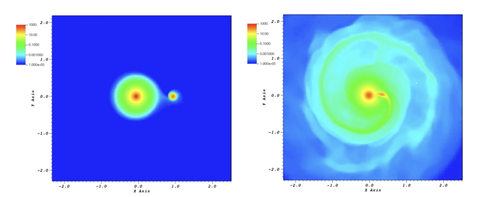Did Betelgeuse eat a star? That could help explain some of its more puzzling attributes.
- A team of researchers have proposed that the star Betelgeuse may have been part of a binary star system and eventually gobbled up its celestial buddy.
- This could help explain why Betelgeuse is spinning so fast, up to four times faster than our sun.
- To explain this anomalously high spin rate, a team developed a series of computer simulations that looked at whether Betelgeuse could have merged with another star
Betelgeuse may have quite the appetite. A team of astronomers led by Manos Chatzopoulos of Louisiana State University have offered up a juicy new theory about the red supergiant star: It may have gobbled up another star.
Betelgeuse lies almost 650 light-years away in the Orion constellation. It’s one of the most recognizable stars in the night sky and became the object of fascination in recent months when it started dimming. At the time, some researchers suggested that it may be on the brink of going supernova—a stellar death that would light up the night sky with an incredible show.
And that would make sense, Betelgeuse is pretty old for a red supergiant, which burn out more quickly than our star. Observations have shown that it has already run out of a key stellar ingredient: hydrogen. That means that helium inside its core has begun to fuse into carbon, according to SyFy Wire. This process would have caused it to expand and, hypothetically, slow down.
But Betelgeuse is strange. It’s spinning much faster than a star at this stage of its life and under these conditions should—around 3 miles a second at its equator. It should be way slower. Astronomers have long puzzled over its curiously high spin rate.
Chatzopoulos’ team has proposed that Betelgeuse was once part of a binary star system. These star systems, where two stars orbit each other, are commonly found across the universe. In some cases, one of the stars is way, way more massive than the other and can, on occasion, slurp up its puny counterpart. When this happens, energy from the gobbled star transfers to the larger, hungrier star and can cause it to spin more quickly.
“We argue that the best scenario that can explain both the fast rotation of Betelgeuse and its observed large space velocity is one where a binary was dynamically ejected by its parent cluster a few million years ago and then subsequently merged,” the researchers write in their paper, which was published last month in The Astrophysical Journal.
To test this theory, the researchers created a series of computer simulations that revealed what would have happened had a star like Betelgeuse sucked up its stellar sibling. It ain’t pretty.
They’ve got a lot more work to do and more computer models to run, but it’s an intriguing theory to explain the strange star’s oddly fast spin.
–
(For the source of this, and many other equally intriguing articles, please visit: https://www.popularmechanics.com/space/deep-space/a33381534/betelgeuse-star-lunch/)










